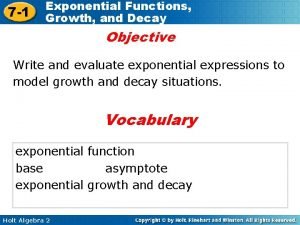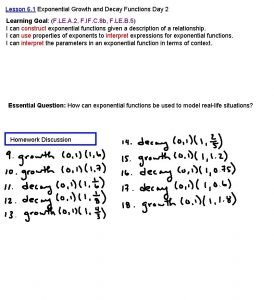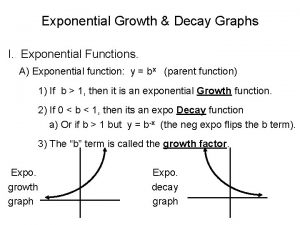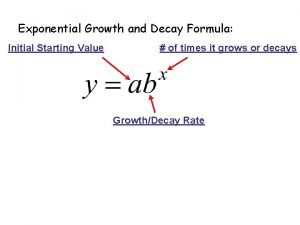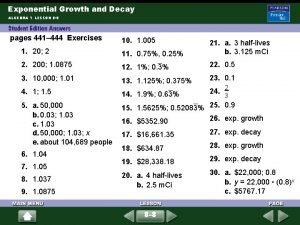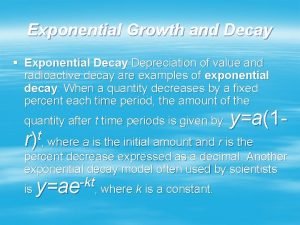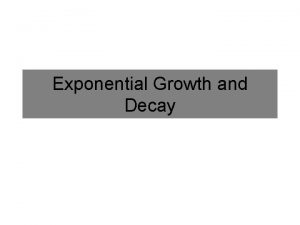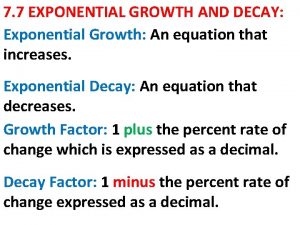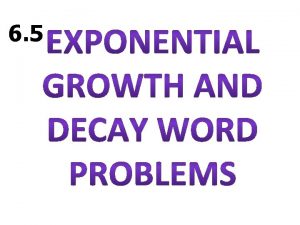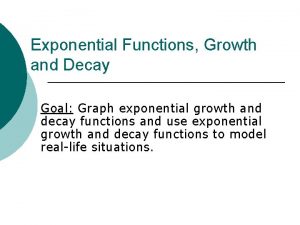CHAPTER 4 1 Exponential Functions Growth or Decay














- Slides: 14

CHAPTER 4. 1 Exponential Functions

Growth or Decay Factors Functions that describe exponential growth or decay can be expressed in the standard form P(t) = Po b t , where Po = P(0) is the initial value of the function P and b is the growth or decay factor. Ø If b> 1, P(t) is increasing, and b = 1 + r, where r represents percent increase Ø Example P(t) = 100(2)t Increasing 2 is a growth factor Ø If 0< b < 1, P(t) is decreasing, and a = 1 – r, where r represents percent decrease Ø Example P(t) = 100( )t , Decreasing, For bacteria population we have P(t) = 100. 3 t Po = 100 and b = 3 is a decay factor

Ch 4. 1 Exponential Growth and Decay Population Growth In laboratory experiment the researchers establish a colony of 100 bacteria and monitor its growth. The experimenters discover that the colony triples in population everyday t days P(t) Population 0 100 Solution - Population P(t), of bacteria in t days Exponential function P(t) = P(0) ( b) t 1 300 2 900 P(0) = 100 P(1) = 100. 3 P(2) = [100. 3]. 3 P(3) = P(4) = P(5) = 3 2700 4 8100 5 24, 300 Exponential function P(t) = P(0) ( b) t The function P(t) = 100(3) t The no. of bacteria present after 8 days= 100(3) 8 = 656, 100 After 36 hours bacteria present 100 (3)1. 5= 520 (approx) Graph

25, 0 00 Graph Of Exponential Growth ( in Graph) 20, 0 00 15, 0 00 10, 0 00 500 0 Population 1 2 3 4 5 Days

Compound Interest The amount A(t) accumulated (principal plus interest) in an account bearing interest compounded annually is A(t) = P(1+ r)t Where P is the principal invested, r is the interest rate t is the time period, in years For Example John invested $ 500 in an account that pays 6% interest compounded annually. How much is in John’s account in 3 years ? Solution P = $500, r = 6, t = 3 years A = P (1 + r) t = 500( 1 +. 06) 3 = 500 (1. 06) 3 = $595. 508

Comparing Linear Growth and Exponential Growth (pg 331) Let consider the two functions Linear Function Exponential function L(t) = 5 + 2 t and E(t) = 5. 2 t L(t) or E(t) Exponential function p( t) = p(0) b t Here E(t) = 5. 2 t 50 y- intercept slope L(t) = 5 + 2 t 0 1 2 3 4 5 t t L(t) E(t) 0 5 5 1 7 10 2 9 20 3 11 40 4 13 80

Ex 4. 1, Pg 324 No 1. A population of 24 fruit flies triples every month. How many fruit flies will there be after 6 months? ? ( Assume that a month = 4 weeks) After 3 weeks ? P(t) = P 0 at 1 st part P(t) = 24(3)t , P 0= 24, a = 3, t = 6 months P(6) = 24 (3)6= 17496 2 nd part t = 3 weeks = ¾ th months ( 4 weeks = 1 month ) P(3/4) = 24(3) ¾ = 54. 78= 55 (approx) Graph and table

Graph Enter Y = 24(3) t , Table

No 4. Pg 334 You got a 5% raise in January, but then in March everyone took a pay cut of 5%. How does your new salary compare to what it was last December ? Solution S = initial salary. After 5% raise, your salary was (1 + 0. 05)S = 1. 05 S • In March the amount 1. 05 S decreased by 5%, so your current salary is (1 -0. 05)(1. 05 S)= (0. 95)(1. 05 S)= 0. 9975 S. • Your new salary is 99. 75% of what it was last DECEMBER.

Ex 4. 1 , No 11 - A typical behive contains 20, 000 insects. The population can increase in size by a factor of 2. 5 every 6 weeks. How many bees could there be after 4 weeks ? After 20 weeks? a) Write a function that describes exponential growth. b) Use calculator to graph the function c) Evaluate the function at the given values Solutiona) P(t) = 20, 000(2. 5) t/6 b) Here we use Xmin = 0 , Xmax = 25, Ymin = 0, and Ymax = 500, 000 c) After 4 weeks, there are P(4) = 20, 000(2. 5)4/6= 36, 840 bees. After 20 weeks, there are P(20) = 20, 000(2. 5)20/6=424, 128 bees

46. Each table describes exponential growth or decay. Find the growth or decay factor. Complete the table. Round values to two decimal places if necessary t 0 1 2 P 4 5 6. 25 Solution - Using (0, 4) , Exponential Function , P ( t) = P 0 bt we have P 0 = 4 Using (1, 5), 5 = 4 b 1 5/4 = b, the growth factor b = 1. 25. Now use P(t) = 4(1. 25) t to complete the table P ( t) = P 0 bt P(3) = 4( 1. 25) 3 = 7. 81 P(4) = 4(1. 25) 4 = 9. 77 3 4 ? ? 7. 81 9. 77

57. a) Find the initial value and the growth or decay factor. b) Write a formula for the function t b 0 P t (0, 80) 0 P = t ) ( 40 b 80 ( 1, 40) P ( P The initial value is 80( when x = 0) , P ( t) = P 0 bt 4 8 80 = P 0 b 0 , P 0 = 80 The graph passes through ( 1, 40), so 40 = 80 b 1 , b = 1/2. This gives decay factor b = ½. An alternate method for finding the decay factor is to notice that the y-values on the graph are halved every time x increases by 1. b) f(x) = 80 (1/2) x

No 70, Pg 339. Over the week end the Midland Infirmary identifies four cases of Asian flu. Three days later it has treated a total of ten cases Solution a) Flu cases grow linearly L(t) = mt + b Slope = m = L(t) = 2 t + 4 t 0 3 6 9 12 L(t) 4 10 ? ? ? 16 22 28 b) Flue grows exponentially E(t) = E 0 at E 0 = 4, E(t) = 4 at 10 = 4 at = at, = a 3 , t = 3 a= = E(t) = 4(1. 357)t = t 0 3 6 9 12 E(t) 4 10 ? ? ? 1. 357 25 Graph 62 156

In Graphing Calculator Flu grows exponentially Flu cases grow linearly P 0 bt
 Growth or decay exponential
Growth or decay exponential Exponential decay function
Exponential decay function Growth and decay of exponential functions
Growth and decay of exponential functions How to tell if a function is decay or growth
How to tell if a function is decay or growth Lesson 7-1 exponential functions growth and decay
Lesson 7-1 exponential functions growth and decay 4-1 exponential functions growth and decay
4-1 exponential functions growth and decay 4-1 exponential functions growth and decay
4-1 exponential functions growth and decay How to find an exponential function from a table
How to find an exponential function from a table Lesson 6 exponential growth
Lesson 6 exponential growth Growth and decay graphs
Growth and decay graphs Rate of growth or decay
Rate of growth or decay Lesson 13-1 exponential growth functions answers
Lesson 13-1 exponential growth functions answers Exploring exponential models practice
Exploring exponential models practice 9-3 exponential growth and decay
9-3 exponential growth and decay 7-7 practice exponential growth and decay
7-7 practice exponential growth and decay



